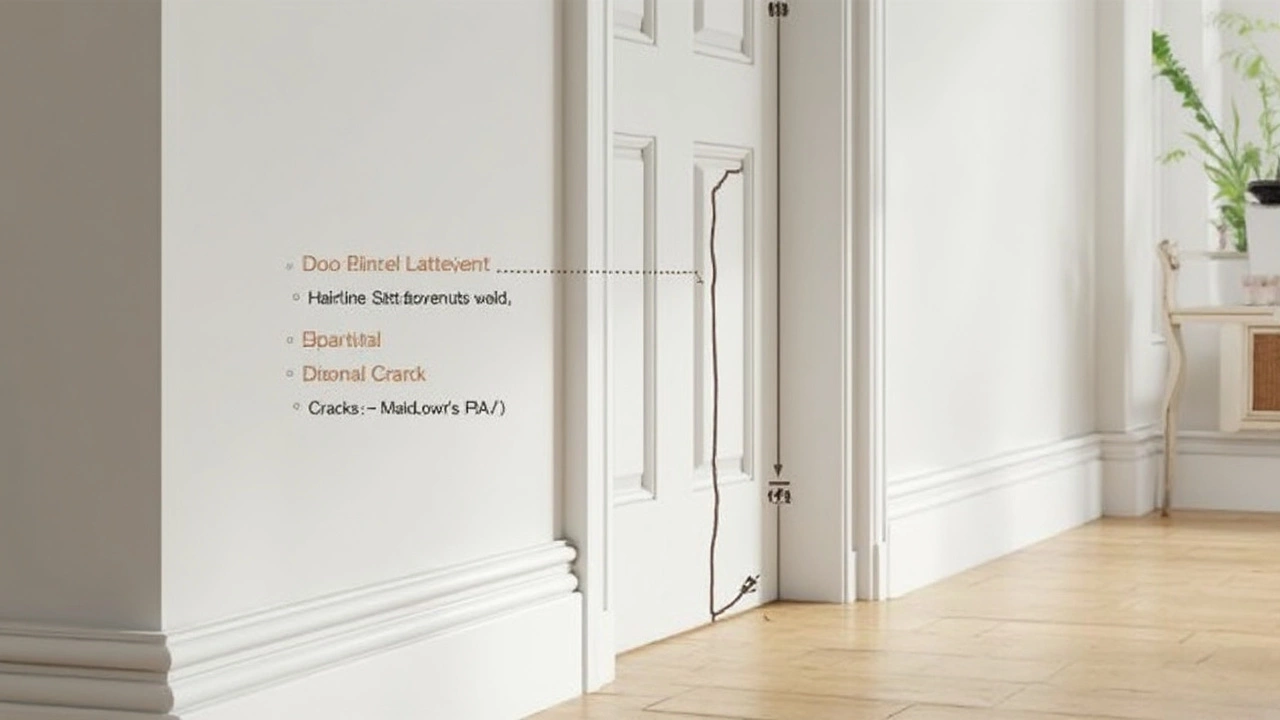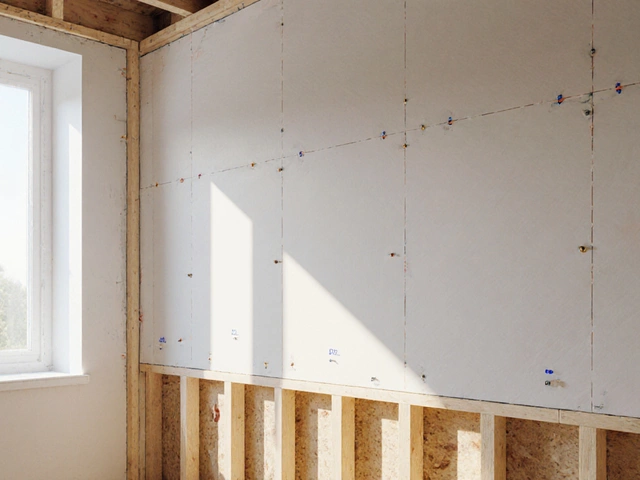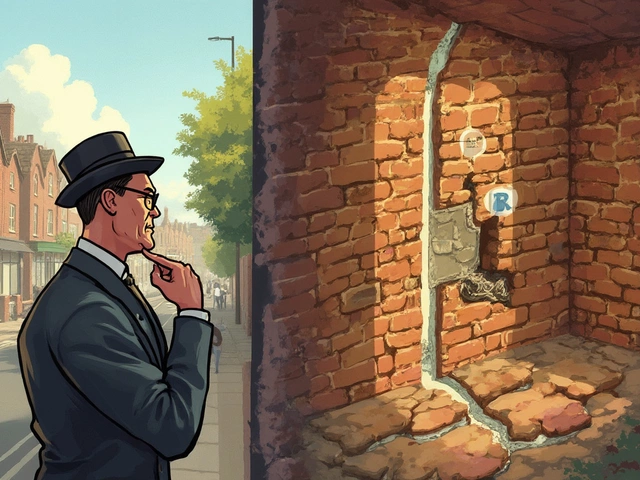Nothing throws off that new home excitement like spotting a crack in your perfect drywall. If you’re anything like me, your mind jumps straight to major repairs and a busted budget. But here’s the real deal: most new homes will crack somewhere. It’s totally normal, especially during the first year.
Your house is new, and like a teenager, it’s still settling in. Canada’s climate means wood, drywall, and even the concrete foundation are constantly expanding and shrinking with the weather. As weird as it sounds, this movement creates cracks in places like the corners of door frames or along the ceiling seams.
The important thing is knowing which cracks are harmless and which ones are warning signs. Some cracks are just drywall doing its thing, while others need a professional eye. If you spot a hairline crack above a window or a little gap under some trim, don’t sweat it. That’s just your house finding its groove.
- Why Cracking Happens in New Builds
- Common Types of Normal Cracks
- Cracks You Shouldn’t Ignore
- When to Call in an Expert
- Tips to Prevent Further Cracking
- Living with and Repairing Cracks
Why Cracking Happens in New Builds
So, why does your brand-new place start showing cracks almost right after you move in? It’s not because the builder messed up (most of the time). Cracking in a new build almost always comes down to natural movement and the materials finding their place. Houses aren’t 100% finished when the paint dries. The biggest reason for cracks, especially in spots like drywall, is something called settlement. Your house is heavy, and it needs time to settle onto its foundation as the ground underneath compacts and adjusts. This usually kicks in big time during the first one or two years.
Materials dry out and shrink, especially in Canada, where our winters mean lots of heating and our summers get humid. Lumber and drywall pull in moisture and then dry out; as they do, they move. This movement leads to small cracks. Even concrete foundations can develop teeny surface cracks as they cure, which is totally normal. Here’s a quick breakdown of why these cracks pop up:
- Drying shrinkage: Framing lumber and drywall lose moisture over time, shrinking and causing seams to pop.
- Temperature swings: Halifax weather is tough—warming up, cooling down—making materials expand and contract daily.
- House settlement: The weight of your new home compresses the soil and foundation, causing minor shifts and cracks above doors and windows.
- New construction moisture: Lots of water goes into things like concrete and plaster. As it all dries out in your first year, new hairline cracks show up.
If you want to put numbers to it, most new Halifax homes will show a handful of cracks in their first 12 months. Some companies, like Tarion (Ontario’s warranty group), say over 80% of new homes will show at least one drywall crack in the first year. Honestly, it’s tougher to find a new build that doesn’t have them.
Common Types of Normal Cracks
Spotting cracks in a new build freaks a lot of people out, but not all cracking is bad. Some cracks are just par for the course and happen to almost every house during that first year, especially in places like Halifax where temps and humidity change a ton.
The most common kind of crack? The classic hairline crack in drywall. These usually show up above door frames, at the corners of windows, and where ceilings meet walls. You might also see small cracks along the seams of your ceiling, especially if your house is on the bigger side with more framing moving around.
- Vertical hairline cracks over windows and doors: These are caused by the house settling and the framing shifting a tiny bit. They're usually super thin—think thinner than your phone charger cable.
- Ceiling seam cracks: Where two pieces of drywall meet, especially in rooms with bigger spans. A little crack is nothing to stress about if it isn’t spreading.
- Baseboard gaps: Sometimes you’ll spot a crack or tiny gap along the edge of your baseboard. This happens as lumber dries out and shrinks. Grab some caulking if the gap bugs you, but don’t panic.
Most of these cracks stay the same size and don’t get much wider. If they’re only about the thickness of a credit card or less, you’re in safe territory. According to the Canadian Home Builders' Association:
"Minor cracking in drywall and along drywall joints is completely normal in new homes. These usually don’t affect the home’s structure and can be repaired easily during routine maintenance."
Here's a quick look at what you might find in new build homes, and what’s considered normal:
| Location | Type of Crack | Typical Width |
|---|---|---|
| Above doors/windows | Vertical hairline | ≤ 1.5mm |
| Ceiling seams | Horizontal/joint crack | ≤ 1.5mm |
| At baseboards | Gap or very fine line | ≤ 2mm |
The main thing is to give the house a chance to settle through its first four seasons. After a year, you can patch these up (or hand the list to your builder if you’re covered by a warranty—totally worth doing). Quick tip: don't rush to repaint or plaster during the first year unless it's driving you crazy. The cracks will likely stop once the house has fully settled.
Cracks You Shouldn’t Ignore
So, not every crack is just your new build settling. A few types should make you pause and maybe even grab your phone. Some cracks are signals that something bigger is up. Let’s get specific about which ones can’t just be patched with a bit of filler and forgotten.
Cracks that are wider than a toonie (about 5mm) are serious business, especially if they run diagonally across walls or ceilings. If you see cracks following stair-step patterns in brickwork or blocks, that could mean foundation problems—this is not something to just paint over. Vertical cracks that go from floor to ceiling or run the length of a wall should raise a flag right away.
Here’s a quick guide you can actually use:
- Horizontal cracks in basement walls—this can mean pressure from the soil outside is really pushing in on your home.
- Cracks that open and close with weather—constant movement might point to moisture leaks or weak structural spots.
- Cracks near windows or doors wider than 3mm—frames shifting can make opening or closing things tough, and it’s not always just settling.
- Cracks paired with sticky doors or slanting floors—often a sign of shifting foundations, especially in areas with clay-heavy soil or lots of freeze-thaw.
If you spot one of these, take a picture and watch for changes over a couple of weeks. Sudden growth is a sure sign to get a pro involved. For context, a 2023 survey from a Canadian home warranty provider showed that less than 5% of cracking issues in new homes need structural repairs —but catching them early is key.
| Crack Type | Possible Issue | Action |
|---|---|---|
| Thin hairline (under 2mm) | Normal settlement | Monitor, but usually harmless |
| Wide vertical/horizontal (over 5mm) | Foundation movement | Call a structural engineer |
| Diagonal/stair-step | Foundation shift | Professional assessment needed |
Don’t stress over every little line. But stay sharp—spotting these bigger issues fast means you’ll have plenty of time to fix things before they get out of hand.

When to Call in an Expert
Some cracks in a new build are just a part of the settling dance, but there are situations where calling in a pro is a smart move. You want someone with fresh eyes—ideally, a structural engineer or experienced contractor—if you spot certain warning signs.
If cracks look like a spider web (multiple directions), run wider than a loonie (over 1/8 inch), or keep growing longer every few months, it’s time to get them checked out. Cracks that appear over doors or windows and keep reappearing, even after a quick patch, might point to structural movement, not just regular house settlement.
Keep an eye out for these signs you shouldn’t ignore:
- Diagonal cracks running from window or door corners down toward floors
- Large, horizontal cracks along basement or foundation walls
- Cracks that are wider at one end than the other—especially on exterior walls
- Gaps between walls and ceilings getting noticeably wider
- Sticking doors or windows near fresh cracks
If you see cracks near the foundation after a big rainstorm or notice a musty smell, extra caution is smart—water might be sneaking in or pressure could be shifting the foundation.
| Type of Crack | Normal? | Expert Needed? |
|---|---|---|
| Hairline drywall crack | Yes | No |
| Crack wider than 1/8 inch | No | Yes |
| Diagonal crack over door | Maybe | If it keeps growing |
| Horizontal crack in foundation | No | Absolutely |
| Vertical crack, less than 1/16 inch | Yes | No |
Here in Halifax, new homes sometimes experience more shifting because of the freeze-thaw cycle. So, if you ever feel unsure, it’s worth the cost of a consult. Better safe than sorry—your peace of mind is worth way more than the inspection fee.
Tips to Prevent Further Cracking
If you’re hoping to avoid those unsettling new cracking lines popping up everywhere, there are a few things that actually help. Most of it comes down to handling moisture and temperature changes, because that’s what messes with building materials the most—especially in Canadian climates like Halifax’s.
One simple move is keeping your house at a pretty stable humidity level, especially in the first year. Dry air in winter can pull moisture from your wood and drywall, which leads to shrinkage and—you guessed it—cracks. Use a humidifier when the furnace is blasting and keep things between 30% and 50% humidity if you can. Lennox’s eczema flared up in dry air, but it also saves your walls, so really, it’s a win-win.
Consistent temperature matters too. Don’t go wild with turning the heat down when you’re not home and then cranking it up to tropical as soon as you walk in. Sudden swings make materials expand and contract too fast.
- Install a programmable thermostat to keep temps even—your drywall will thank you.
- If your new house has a basement, make sure it’s not getting too damp. Dehumidifiers help if you’re noticing that clammy feeling downstairs.
- Don’t block heating vents with furniture, since that messes with air flow and can create hot and cold spots, stressing your walls even more.
- Keep gutters and downspouts clear so water flows away from the foundation. Foundation movement is a big cause of serious cracking.
There’s an old builder saying:
“A house is always moving just a little. The goal isn’t to stop it, but to keep it moving slowly and evenly.”
You don’t want quick or uneven movement. If you do see cracking getting worse quickly, especially in the first few months, it’s time for a pro to check it out. But for the usual little hairline stuff, keeping the inside calm and dry is about the best you can do.
Living with and Repairing Cracks
If you’ve just moved in and see some cracking in the drywall or even in the foundation, don’t pull your hair out yet. Minor cracks are part of the new build life. Builders in Halifax—and honestly, anywhere in Canada—expect most homes to show a few small hairline cracks after the first freeze-thaw cycle. It’s not a sign your place is falling apart.
So, what should you actually do about these? For small cracks (thinner than a toonie), most experts agree it’s best to just live with them for your first year. Your home is going to keep shifting through all four seasons. If you patch cracks too early, you’ll probably see them come back, and that’s just extra work. Wait until your house has gone through at least one full Halifax winter and summer.
If you’re hitting the one-year mark and cracks are still showing—or new ones are popping up—it’s time to take action. Here are steps to tackle everyday cracking:
- Use a utility knife to gently widen the crack just a bit so the filler sticks better.
- Vacuum up any loose dust.
- Fill the crack with a good-quality joint compound or elastomeric caulking for wider gaps.
- Let it dry, then sand it smooth.
- Prime and paint to match your wall. No need to hire anyone unless it’s over your DIY skill level.
For new build warranty claims, snap photos of troublesome cracks, note the dates, and keep everything organized. Builders usually cover stuff like drywall cracks during the first year or two. Check your warranty paperwork—each province and territory in Canada has its own rules. In Nova Scotia, most new homes come with a seven-year warranty for structural issues, but cosmetic repairs are usually covered for the first year only.
Some people ask, “If I repair a crack, will it hurt my home value?” Not for minor stuff. Buyers expect some settling. But if you ever spot major cracks (wider than 6 mm, or ones running through concrete), get a pro in before reaching for the putty knife. That could signal bigger foundation shifts or moisture issues you don’t want to ignore.
And just to give you an idea, one survey showed nearly 80% of new build homes reported at least one drywall crack after their first year. It’s basically a rite of passage—just like having Lennox track mud all over the floor on moving day. Learn to spot what matters, patch up the rest, and your house will feel like home—cracks and all.







